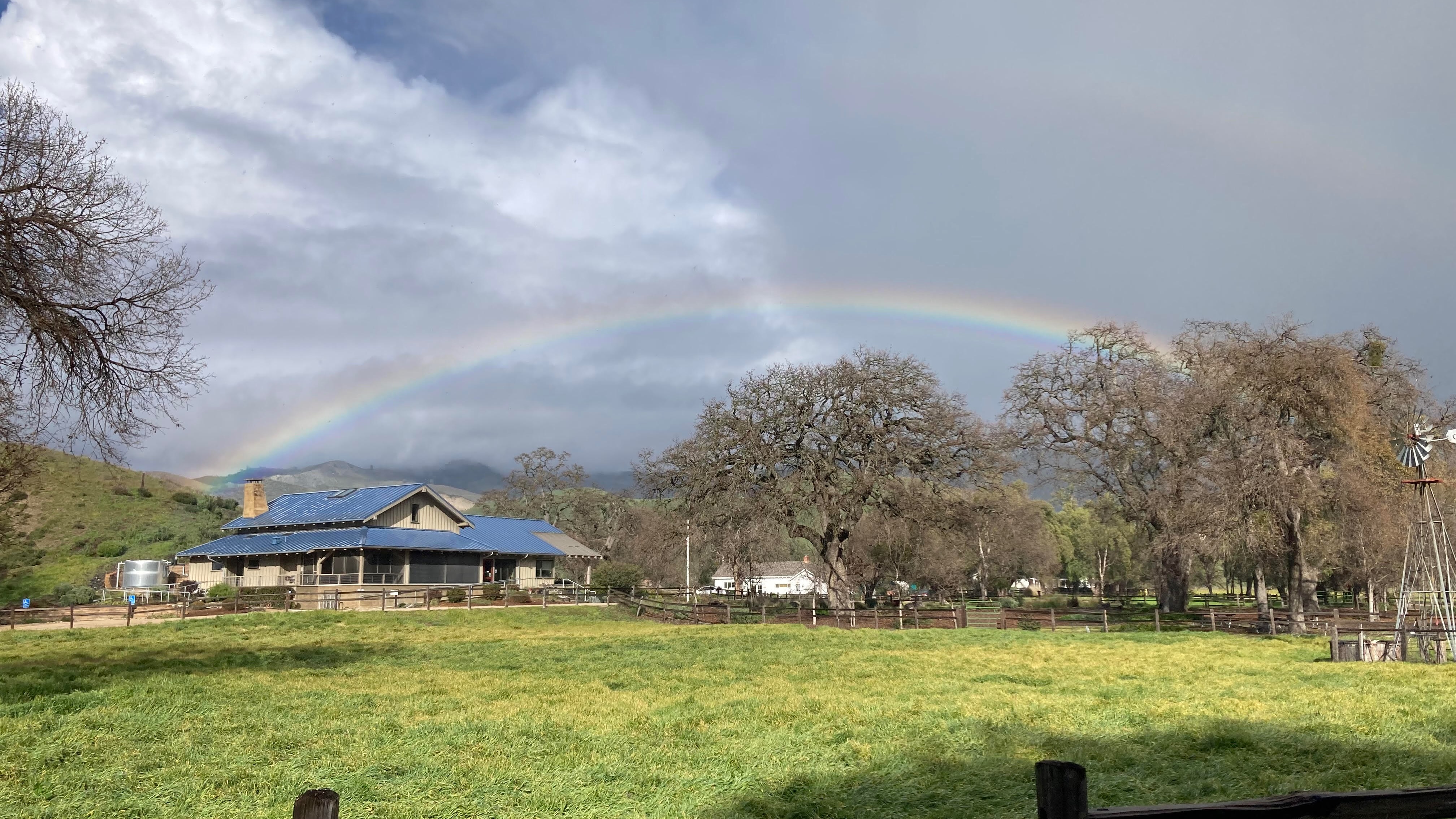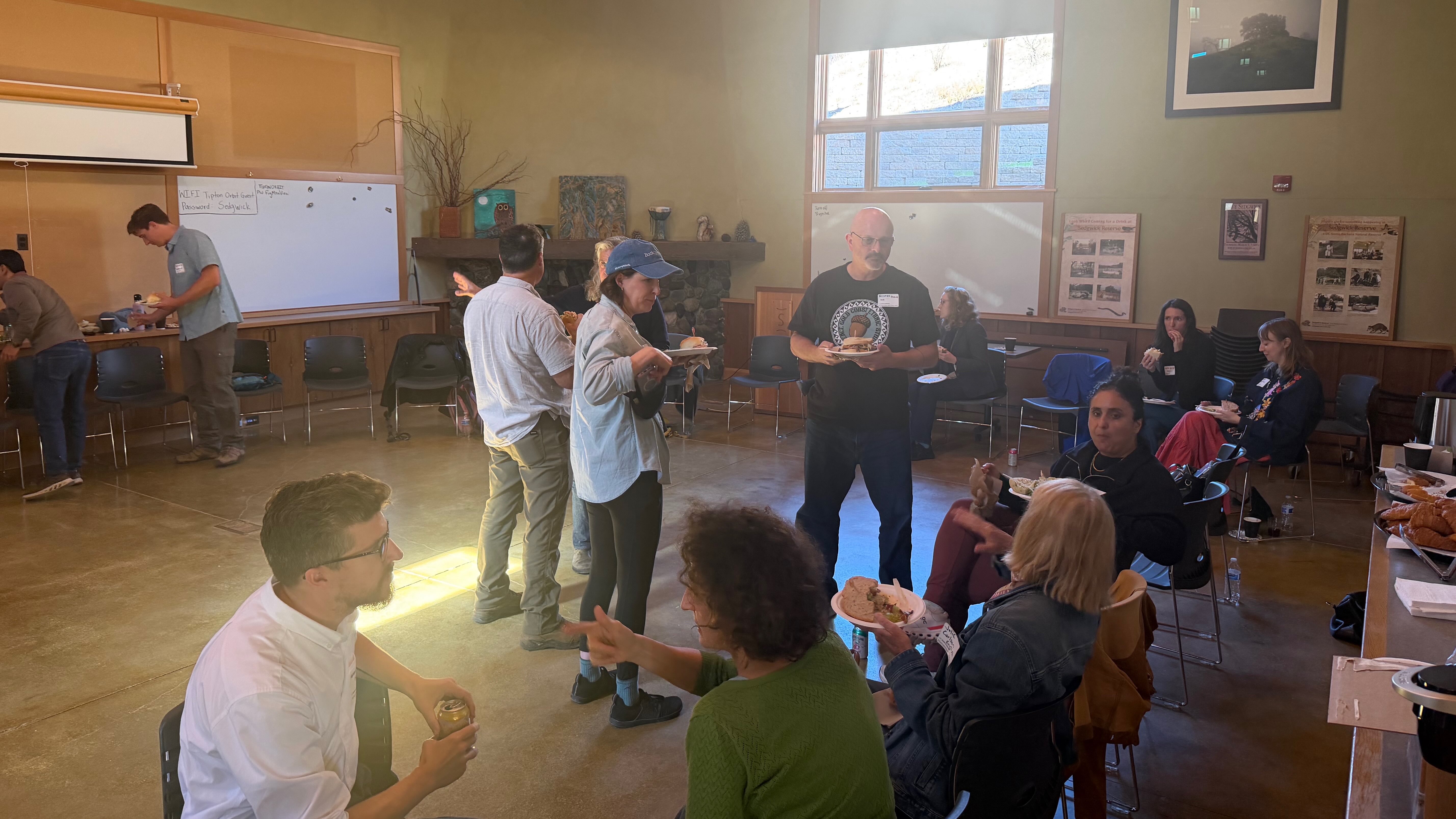
Faculty and staff convene at UC Sedgwick Reserve to reflect, reconnect and plan for the future of HFA.
In the inspiring and beautiful setting of the UC Sedgwick Reserve, faculty, staff and leadership from the Division of Humanities and Fine Arts (HFA) gathered on Monday for a critical half-day retreat. The event, “A Conversation at Sedgwick,” was designed as an opportunity to “strategize together in a time of crisis” and discuss “what we care about most at our public university.”
Conceived and led by faculty organizers Joseph Blankholm, Greg Johnson and Natchee Blu Barnd, and hosted by Dean Daina Ramey Berry, Michael Douglas Dean of Humanities and Fine Arts, the retreat focused on building community and defining a clear strategy to champion the division's collective value.
“The idea for this retreat started with the observation that things are hard right now, and we need to get together and support each other,” said Joseph Blankholm, associate professor of religious studies. “We wanted a way for staff and faculty to talk about the challenges we’re facing but also what we love about the university. How can we care for what we care about?”
The choice of setting was intentional, connecting the division to the creative and vibrant roots of the reserve’s founders. Francis “Duke” Minturn Sedgwick and his wife Alice de Forest-Sedgwick, purchased the property in 1952. Both ardent supporters of the arts — Duke a sculptor, novelist and art collector and Alice, a pianist educated at the Juilliard School of Music — gifted the majority of the ranch to the University of California in 1967.
Following advocacy from UCSB faculty and the community to preserve the property in its entirety, the property was fully transferred to the UC Natural Reserve System in 1997, establishing the nearly 6,000-acre ranch as it exists today. This provided a deeply appropriate backdrop for the division to reflect on its mission and future.
Professor Greg Johnson, director of the Walter H. Capps Center for the Study of Ethics, Religion, and Public Life, added that the goal was to “start with our faculty and staff to introduce them to the possibility [of Sedgwick], so that hopefully there’ll be follow-through to enrich the humanities’ engagement across campus in these rural spaces.”
"We were thrilled to host the Humanities and Fine Arts division and invite their fresh perspectives,” said Sedgwick Reserve Director Heather Constable. “We encouraged everyone to visit the Tack Room in the barn, which details the history of this land—from its Chumash origins to its legacy as a working ranch. It's a special place, and we're excited to see HFA reconnect with its deep artistic roots here."
In her opening remarks, Dean Berry, acknowledged the “period of significant uncertainty" facing higher education but emphasized that “in times of challenge, our work becomes more essential than ever.”
She outlined three core ideas for HFA to move forward, which guided the day's group discussion and breakout conversations.

Leading the public conversation
The day’s main discussion, which brought together faculty and staff, focused on concrete strategies for public outreach and education. Participants brainstormed ideas including developing new training for faculty who want to speak to broader audiences, expanding public lecture series and extension-style programming, and more robustly showcasing diverse humanities career paths to students and parents.
This focus on engagement was the first charge Dean Berry outlined for the division. “The world needs humanists and artists to frame the most pressing issues of our time,” she noted, highlighting the success of initiatives like the Public Voices Fellowship in empowering faculty to shape national dialogues.
There was strong agreement, noted by Dean Berry, that this work must begin on campus and extend into the wider community through alumni testimonials and departmental newsletters.
Celebrating innovative collaborations
The second theme called for the division to “celebrate and expand our innovative collaborations,” pointing to groundbreaking work in the digital humanities and community-based programming. “These projects are the future, and we must continue to foster them,” said Dean Berry.
Faculty and staff identified these in-person gatherings as the fertile ground where such collaborations begin. Professor Stephan Miescher of the Department of History noted the importance of faculty and staff connecting directly. “I think they [faculty] talk among each other, but there is less communication between faculty and staff,” he observed. “This builds community, and online it doesn't build community as much.”
Recommitting to community
The final and most central theme of the day was a “recommitment to this community.”
Attendees echoed this need for dedicated time to connect. “I think it’s really, really important that we get together in person,” said Professor Miescher. Professor Johnson noted the unique power of the off-campus setting. “I think the novelty of being in a new space, in nature, I think that’s vitalizing,” he said. “That just changes the dynamic and sets a foundation for how then we can relate otherwise.”
Dean Berry crystallized this feeling in her remarks. “Our greatest resource is our people,” she stated. “In a time of institutional pressure, supporting one another is not a passive act but a strategic priority.” She used the powerful metaphor of the coast live oak, Santa Barbara’s native tree, urging attendees to “deepen our roots in each other — offering strength and shelter, especially in dry seasons.”
The conversation also included candid discussion about the need to create a new, supportive narrative for staff facing concerns over job security and to improve information sharing for all members of the HFA community. “I think people are really hungry for this,” said Professor Beth Digeser. “We’ve been hungry for connection and an opportunity to be who we are.”
Looking forward
The day concluded with lunch and informal conversations, giving faculty and staff from across HFA a rare opportunity to connect outside of campus.

The retreat provided an energizing foundation for the work ahead.
As Dean Berry concluded in her remarks, “Let’s reimagine what is possible for the humanities and fine arts, together.”
Header photo by Kristen Zumdahl.